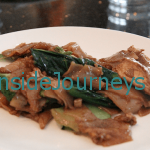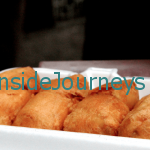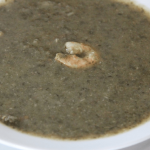One of the perks of living in a city the size of New York is the diversity it offers, not only in things to do but also in culinary offerings. Food from almost every nation is represented here.
Last weekend, my friend Joan and I joined Ahoy New York for their Food Tasting and Cultural Walking Tour of Chinatown and Little Italy. We started in Little Italy and ended the tour in Chinatown.
New York City’s Chinatown is a bustling neighborhood that is home to the largest population of Chinese outside of China – approximately 100,000. The neighborhood now occupies an area of about 2 miles stretching south roughly to Chambers Street, east to the Lower East Side, north to Little Italy and west to Broadway/Tribeca.
A Short History of Chinatown
In the mid-1800s, Chinese immigrants, men mostly, headed west to California, Gold Mountain as they called it, lured by dreams of striking it rich. Instead of gold, they found limited opportunities for work. Their dreams evaporated and with no money to return home or to send for their families their dreams they moved east.
Arriving in New York City, these former residents of Canton, settled in the area around Mott, Pell and Doyers Streets and worked as cooks and launderers, jobs usually done by women. They brought their language, culture and culinary traditions like dim sum, bite-sized foods served steamed or fried. Dim Sum has its origins in the famous Silk Road when tea houses opened to accommodate weary travelers.

Our first stop was Pongrsi Thai Restaurant on Bayard Street, the oldest family-run and operated Thai restaurant in New York City. Started by Khun Pongrsi and her husband Khun Prasit Tangchakkrachai, Pongrsi has been serving authentic Thai food in the same place since 1972. It is credited with popularizing Thai food in the city.
After walking around for the better part of the morning, the chance to sit and enjoy the meal was quite welcome. We sampled Orange Chicken, Chicken Pra Ramm (peanut sauce/curry dish) and a Pad See Ew.
My favorite, the Orange Chicken, was unlike any I’ve had. The orange was subtle enough to provide a delicious balance to the chicken. By the time the plate got to me, though, only a few pieces were left – it was that good. I really love Thai food so you can bet I’ll be back to Pongsri very soon.
Leaving Pongsri, we walked through Columbus Park, and made a brief stop on Mulberry in the Five Points section of Lower Manhattan. You might remember Five Points, that notorious section of the city that was the setting for the movie, [simpleazon-link asin=”B004SIP7TE” locale=”us”]Gangs Of New York[/simpleazon-link].
Five Points got its name from the five-pointed intersection created by Orange now Baxter Street, Cross now Mosco Street, Anthony now Worth Street and Little Water Street, which or no longer exists. Today, that part of Mulberry Street is lined with funeral homes that serve the community.
Soon we arrive at Tasty Dumpling, 54 Mulberry, for our first Chinese tasting. Can you guess what we sampled at Tasty Dumpling? Why, dumplings, of course!
Tasty Dumpling’s dumplings get rated consistently as the best dumplings in Chinatown – and at 5 for $1.25, are a tasty bargain. That probably explains why nearly all the tables in this small eatery were occupied when we arrived so we crowded into the only free space – at the left of the counter.
A woman was at the stove loading freshly made dumplings into a huge steamer while in the back two others were adding the filling to the dough.
Our dumplings were still warm when they arrived. Liz added a soy-white vinegar sauce and passed them around. The wrapper was nice and firm and so translucent I could see the filling, and when I took a bite, it was moist and tasty, the dipping sauce adding a nice kick.
Leaving Tasty Dumpling, we crossed over to Mott Street then to Doyers to Nom Wah Tea Parlor, our last stop on the tour. Nom Wah, the oldest dim sum restaurant in Chinatown has been around and on the same block of Doyers Street since the 1920s.
The Choy family owned the restaurant until they sold it in 1974 to Wally Tang, a longtime employee. Mr. Tang started working at Nom Wah in the 1950s when he was 16 and began managing it when he was 20.
Little has changed to the exterior of Nom Wah but Wilson Tang, the new manager and the next generation of Tangs, has upgraded the interior. Wally and his team of dim sum experts still keep an eye on things though.
It was about 1:00 pm when we arrived and diners were clustered outside in groups of twos and threes waiting for tables. Someone from the restaurant would come to the door and call the next name on the list as tables became free. Good thing Liz had placed our order ahead of time so we didn’t have to wait.
Nom Wah’s original egg rolls are round and fat. Stuffed with chicken and vegetables, they are rolled in egg crêpe then fried in homemade batter which makes them crisp and flaky. Despite being fried, they aren’t greasy. Each egg roll was cut in two and each of us got half but after all the food we’d sampled, one piece of this delicious treat was enough.
We had come to the end of our three hour tour and it was time to say goodbye to Liz, our very enthusiastic tour guide. I’m sure all of Ahoy New York’s tour guides are knowledgeable, warm and sociable but Liz makes you feel like she’s giving a tour with long time friends.
To recap, we visited Alleva Diary, DiPalo’s Fine Foods, Grand Appetito and Ferrara Bakery & Cafe in Little Italy, and Pongsri Thai Restaurant, Tasty Dumpling and Nom Wah Tea Parlor in Chinatown. We did a quick stop at the Italian American Museum, which I’ll cover in another post.
Joan and I spent the rest of the afternoon and evening in Chinatown. We had dinner at one of the cellar restaurants on Mott Street that Liz had pointed out then ended up at a wine tasting at Enoteca DiPalo’s. (More about these later.)
One thing I forgot to mention: my friend Joan has severe allergies to shellfish and Ahoy was able to arrange other dishes for her to sample on the Chinatown part of the tour.
Please note: I found this recipe for Thai Orange Chicken at Allrecipes.com.
Disclosure: We were guests of Ahoy New York on this Chinatown and Little Italy Food Tasting and Cultural Walking Tour, but as usual, the opinions expressed here are our own. Thanks to Ray and Alana, and Liz, our very knowledgeable, very entertaining and very enthusiastic tour guide.
Recommended Reading
[simpleazon-link asin=”0738550183″ locale=”us”]New York City’s Chinese Community (Images of America: New York)[/simpleazon-link], Josephine Tsui Yueh Lee
Can you name one popular Chinese dish that you won’t find in China?
How to join the #FoodieTuesday linkup –
- Add the link to your foodie post in the link tool at the bottom of this post
- Leave a comment.
- As a courtesy, please include a link back to this post.
- Tweet, G+, Like, etc., using the hashtag #FoodieTuesday
 Loading InLinkz ...
Loading InLinkz ...



















































